Resources

There's so much to know, but here is a good place to start...
This page contains links to articles, websites and other resources we want you to have access to in order to help you make informed decisions about your maternity care.
Water birth
Waterbirth is a choice that many women ask about. They ask "is it safe" "does the baby breathe?" "what benefits does it offer?"
Yes for low risk women water birth is just as safe as birth on dry land. Follow this link
to see data on outcomes for babies.
The tub creates a personal space and allows freedom of movement. Buoyancy in water allows for positions not easy to hold on land. The warmth of the water helps women to relax and softens muscles.
In utero babies are not breathing, they get their oxygen supply through the umbilical cord, when they emerge into air they begin breathing. If the baby emerges into water it continues to receive its oxygen through the cord until it is lifted from the water.
We have birth pools for hire, they come with a disposable liner and an air pump for inflation.
Cord clamping
When do we cut the cord?
We recommend leaving the cord intact until the placenta is born or until the cord is white, here's why.
When your baby is in utero about 1/3 of their blood is in the placenta at any one time. The placenta does the job of the lungs and liver, among other things, by exchanging CO2 for oxygen and nutrients for waste products. The lungs and liver of your baby have limited blood supply in utero, enough to grow but not as much as will be needed to function when the baby is born. Once the baby is born the blood in the placenta is needed by the baby as the lung tissue expands and begins the job of gas exchange and by the liver as the baby begins eating and digesting.
Newborns have about 80-100ml of blood per kg of body weight. So a 3.5kg baby will have around 290-350ml of blood. If 1/3 of that is left in the placenta (if the cord is clamped and cut immediately) then some babies can struggle to adjust to life outside the womb.
Research tells us that babies who receive all their cord blood have better iron levels at 12 months of age and greater neuro development than babies who have their cords cut immediately.
follow this link
to see the research.
In rare circumstances this is not possible, ask us about this when we meet.
Skin to skin contact
Skin to skin contact immediately after birth and in the weeks after birth has enormous benefit to babies. Skin to skin has been shown to help regulate a baby's blood sugar levels, their respiratory rate and heart rate. Babies held skin to skin also cry less. Skin contact helps to facilitate breastfeeding and helps with colonisation of the baby's gut with maternal bacteria.
Have a look at this link
for the full story of the sacred hour after birth and the value of skin to skin contact with Mum and Dad.
